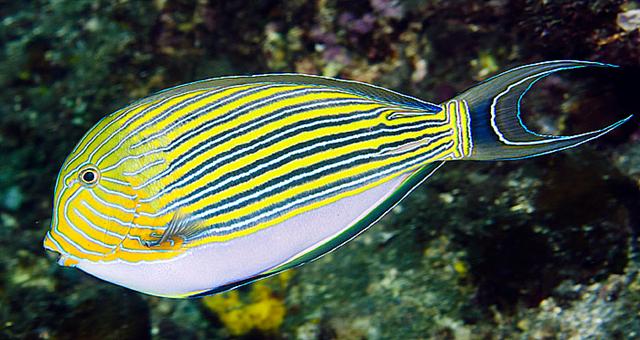| Acanthuridae (Surgeonfishes, tangs, unicornfishes), subfamily: Acanthurinae |
| 38 cm TL (male/unsexed); max. reported age: 46 years |
|
reef-associated; marine; depth range 0 - 15 m |
| Indo-Pacific: East Africa, including the Mascarene Islands (Ref. 37792) to the Hawaiian, Marquesas and Tuamoto islands, north to southern Japan, south to the Great Barrier Reef and New Caledonia. Replaced by the closely related Acanthurus sohal in the Red Sea. |
|
Dorsal spines (total): 9-9; Dorsal soft rays (total): 27-30; Anal spines: 3-3; Anal soft rays: 25-28. This species is distinguished by having the following characters: body deep and compressed, depth 2.1-3 times in standard length or SL (body of juveniles relatively deeper than that of adults); snout 5.2-5.7 times in SL; mouth small; teeth spatulate, close-set, with denticulate edges; total gill rakers on first gill arch 14-16; continuous unnotched dorsal fin IX,27-30 soft rays; A III,25-28; caudal fin deeply lunate with concavity 3.3-4.5 times in SL; a lancet-like spine on each side of caudal peduncle which folds into a deep horizontal groove, this spine long, 1.9-2.5 times in head length, and venomous; stomach thin-walled. Colour of body with upper 3/4 with alternating black-edged blue and yellow stripes and those on the head mainly diagonal; lower fourth pale lavender to bluish white; dorsal fin finely striped pale blue and yellowish; anal fin grey with a yellow basal band and a light blue margin; caudal fin blackish with a large, grey crescent centroposteriorly, edged at the front in bluish white and at the posterior margin with black; pectoral fins are pale except basally where they are coloured like the body; pelvic fins yellow-orange with a white lateral margin and a blackish submarginal line (Ref. 9808). Description: Philippine specimens demonstrate different color patterns. |
| Benthopelagic (Ref. 58302). Adults usually form schools and commonly found in shallow gutters. Juveniles solitary and secretive on shallow rubble habitats (Ref. 48637). A territorial species (Ref. 167) which is common in surge zones of exposed seaward reefs. The large male controls well-defined feeding territories and harems of females (Ref. 1602, 48637). The species is almost continually in motion. Herbivorous but also feeds on crustaceans (Ref. 5503). Forms spawning aggregations (Ref. 27825). Diurnal species (Ref. 113699:31); courtship takes place at various times of the day, spawning peaks in the morning, but may also occur from midday to afternoon, and is often confined to ebb tides (Ref. 38697). The venomous caudal spine can cause painful wounds. |
|
Least Concern (LC); Date assessed: 03 May 2010 Ref. (130435)
|
| venomous |
Source and more info: www.fishbase.org. For personal, classroom, and other internal use only. Not for publication.
